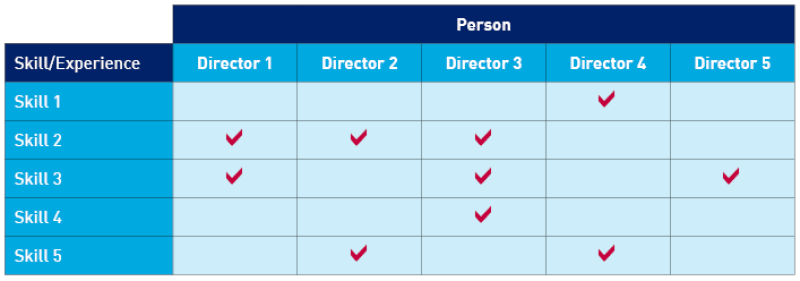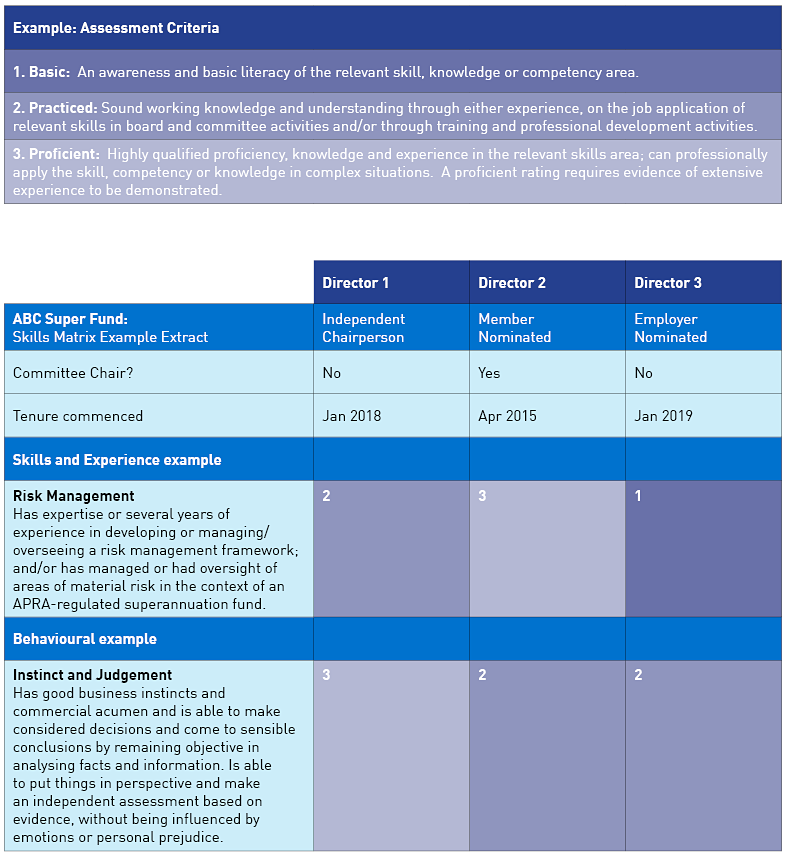Superannuation: How a skills matrix can help transform board capability
In a recent speech to the superannuation industry, APRA Deputy Chair Helen Rowell discussed shortcomings in the governance practices of some boards. “A best practice board is needed to drive delivery of better outcomes for superannuation members,” she said. Mrs Rowell noted that best practice boards adopt robust succession plans, informed by strong skills matrices, to build diverse boards that are strategic and able do the work that is needed now, with a focus on the future.
But what is a strong skills matrix, why is it important, and how can it be used to enhance the capability of superannuation fund boards, as well as boards of other APRA-regulated entities?
Board capability and skills matrices
Boards of superannuation funds currently manage almost $3 trillion in retirement savings on behalf of 16 million Australians. Australia’s 20 largest APRA-regulated superannuation funds are significant financial institutions, with their net assets under management having grown from $400 billion in 2010, to $1.4 trillion in 2020. This is a privileged position that brings with it tremendous responsibility – every decision and action taken by boards impacts the retirement outcomes of members.
As such, and noting the significant challenges and changes taking place within the industry (economic, regulatory, technological, competitive and behavioural), it is vital that boards maintain a strong focus on operating at their best, and are well-positioned to adapt as needed.
To operate effectively, boards of superannuation funds need technical skills and an excellent understanding of their membership. They also need diversity (of skills, experiences and perspectives), together with the behavioural competencies and leadership capabilities that will allow them to operate effectively and apply their directors’ range of skills. APRA broadly refers to this as board capability.
A skills matrix is a visual tool which is used by boards to clearly illustrate the skills and competencies of its directors, both individually and as a collective.

A strong skills matrix supports the development of board capability, and helps to ensure that the board is – and continues to be – fit for purpose. It’s a tool whose use is widely considered good governance; indeed, Recommendation 2.2 of the ASX Corporate Governance Principles states that a listed entity should have and disclose a board skills matrix setting out the mix of skills that the board currently has or is looking to achieve in its membership.
APRA expects to see the use of skills matrices embedded in the governance frameworks of all entities that it regulates, regardless of industry. Looking ahead, a strong skills matrix will also greatly assist boards in preparing for the extension of the Financial Accountability Regime to the superannuation industry.

Using a skills matrix
A strong skills matrix can play a key role in a board’s governance framework by informing important practices that support optimisation of board structure and composition, such as:
- Board appointments, renewal and succession planning.
- Board and director training and development.
- Processes for the selection of directors for committees.
- Action plans to address critical skills gaps via other means.
In the superannuation industry, a skills matrix is particularly useful in informing nominating bodies to ensure that candidates for director vacancies address the needs of the board. Over time, the outcomes of the skills matrix review and assessment process should provide a rich source of data and insights – about the effectiveness of development activities, new or emerging skills gaps, recruitment and succession planning needs, and the adequacy of the processes for nominating directors. Skills matrices also empower boards to resist nominations for director vacancies that don’t deliver the board’s competency needs, or meet the board’s expectations.
Designing a strong skills matrix
A strong skills matrix sets out the current and future capability needs of the board at both a collective and individual director level. These capability needs relate to the delivery of the board’s business strategy, taking into account existing challenges to the board’s business operations as well as the changing external environment.
Each board’s specific needs will differ, so a strong skills matrix is designed for its own circumstances. For example, a superannuation fund board with a sophisticated investment strategy will need directors with skills to support the board’s role in the oversight of that strategy. Similarly, a superannuation fund board with an innovative technology strategy may need directors and senior management with contemporary skills and business experience in technology-related fields.
APRA has observed the following common features in strong skills matrices:
- The board’s needs – including technical, soft skills and behavioural aspects – are clear and relevant.
- Any specific minimum requirements are set out for the board as a collective, as well as for individual directors and key roles.
- Assessment criteria are clear and can be consistently applied.
- The relative importance of each need is identified to support analysis and action plans.
The design of a strong skills matrix minimises scope for over or understatement of competency and experience. Inaccurate completion can lead to material gaps, vulnerabilities and improvement opportunities going undetected, creating a false sense of assurance. The example below shows how a board can provide a useful articulation of its skills matrix assessment criteria, and also explains the need for both a technical and behavioural capability area.

Strong skills matrices also identify the relative importance of each capability area and clearly set out any minimum requirements to allow insightful analysis and communication of findings. For example, the illustration below shows a board that has identified ‘investment risk management’ to be an important skill need, but its skills matrix has identified a material gap in the board’s capability. The skills matrix has also identified a strength in its ‘technology and digital’ capability, but places less importance on this area.

To ensure that a skills matrix continues to be a useful tool, each board must review and update their skills matrix regularly to capture changes to board capability needs – as the board’s strategy, operating environment and risk profile change, and as the skills and experience of directors change. This can be achieved through a regular (e.g. annual) review process.
Using independent experts
APRA has observed the benefit of using an independent expert on a regular basis, to support the development and implementation of a board skills matrix, the objectivity of the process, and the analysis of outcomes. Self-assessment has limitations which can lead to a lack of consistency, challenge and/or accuracy in outcomes. The process of completing, updating or validating the skills matrix can usefully form part of the annual board performance review.
To inform or validate the skills matrix, a board should consider including interviews and observational assessments to explore and validate stated skills, experience and behaviours (such as leadership qualities, conduct in meetings, depth and ability to apply experience and knowledge). In order to support the development of directors, it is important that a person such as the assessor or the Chair discusses the outcomes of the skills matrix and the board’s needs with each director, and that this be incorporated into their training and development planning.
Going forward
A strong skills matrix is an effective tool to help boards of APRA-regulated entities to strengthen their capability so that they can address the increasing demands and expectations surrounding their important role in the Australian community.
Strong skills matrices underpin effective processes for developing board capability and managing key person risk through, for example, robust succession planning. This in turn can avoid the need for boards to invoke special circumstances for director renewal, which can often be linked to ineffective succession planning.
As APRA seeks to transform board capability within the superannuation industry and hold boards accountable for the identification of skills gaps and strategies to address these gaps, skills matrices will be a valuable tool through which structured discussions on board capability can occur.
The Australian Prudential Regulation Authority (APRA) is the prudential regulator of the financial services industry. It oversees banks, mutuals, general insurance and reinsurance companies, life insurance, private health insurers, friendly societies, and most members of the superannuation industry. APRA currently supervises institutions holding around $9.8 trillion in assets for Australian depositors, policyholders and superannuation fund members.